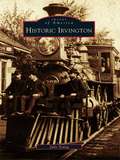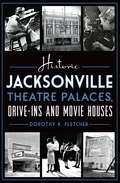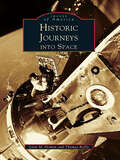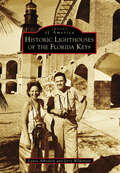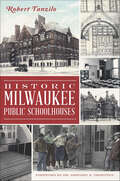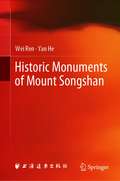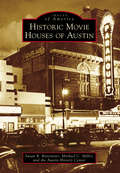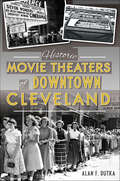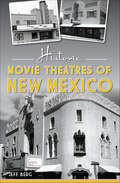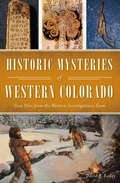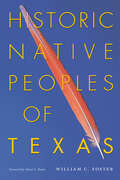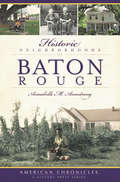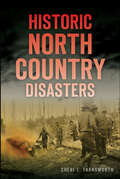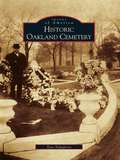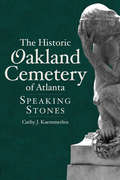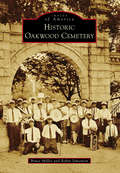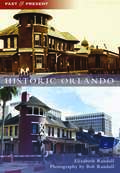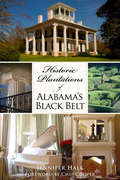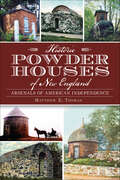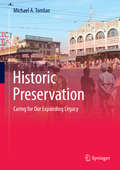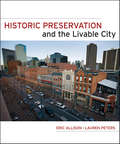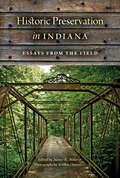- Table View
- List View
Historic Irvington (Images of America)
by Julie YoungFounded in 1870, historic Irvington serves as a time capsule to the bygone days of the Victorian and Edwardian eras. The once autonomous community along the Pennsylvania Railroad and U.S. Route 40 has a history as rich and spellbinding as the legendary tales of its namesake, Washington Irving. Featuring plenty of architectural diversity and notable citizens, Irvington served as the original home to Butler University and became known as a cultural, arts, and academic pillar of the Indianapolis landscape. Today Irvington continues to be the gem of Indianapolis's east side with locally owned shops and businesses along with a community that is committed to the past while focusing on the future.
Historic Jacksonville Theatre Palaces, Drive-ins and Movie Houses (Landmarks)
by Dorothy K. FletcherJacksonville's theatre and performance history is rich with flair and drama. The theatres, drive-ins and movie houses that brought entertainment to its citizens have their own exciting stories. Some have passed into memory. The Dixie Theatre, originally part of Dixieland Park, began to fade in 1909. The Palace Theatre, home to vaudeville acts, was torn down in the '50s. The Alhambra has been everyone's favorite dinner theatre since 1967's debut of Come Blow Your Horn. Local author Dorothy K. Fletcher revives the history of Jacksonville's theatres. Lights, camera, action!
Historic Journeys Into Space (Images of America)
by Lynn M. Homan Thomas ReillyFrom the January 1958 launch of the first American satellite to the creation of the National Aeronautics and Space Administration by President Eisenhower just a few months later, from the heated space race of the Cold War era to the heroes of shuttle launches, the United States has been on the leading edge of space exploration and technology. Initially developed from one of Adolph Hitler's most feared weapons, the V2 rocket, the space program has accomplished much in just a few short decades. The first American manned space flight, which put astronaut Alan Shepard into space, was launched in 1961; in 1965, Edward White became the first American to walk in space--for a total of 21 minutes. In 1969, Neil Armstrong uttered those now-famous words as he became the first human to walk on the Moon. These and many other achievements, once considered unimaginable, have inspired and amazed the American people and engaged our brightest scientific minds.
Historic Lighthouses of the Florida Keys (Images of America)
by Jerry Wilkinson Laura AlbrittonThe Florida Keys possess a staggering wealth of lighthouses--nine in all, from the remote iron light at Fowey Rocks to classic brick structures at Key West and Loggerhead Key. In the 1820s, the US government began constructing lighthouses to aid mariners navigating the dangerous Florida Reef. While some of the original lights were subsequently destroyed in dramatic circumstances, most that followed, including Carysfort Reef, Alligator Reef, Sombrero Key, Sand Key, and American Shoal, survived intense tropical weather and even major hurricanes. Among the lighthouse keepers were remarkable women who succeeded in a profession usually reserved for men.
Historic Milwaukee Public Schoolhouses (Landmarks)
by Robert TanziloIt's no surprise we feel a connection to our schools, where we learn to read, write and forge social bonds of all kinds. They are potentially the scenes of our first crushes (and the second and third). They are where we learn to create ourselves. For more than a century, Milwaukee has taken its schoolhouses seriously, and it has a matchless variety of gorgeous landmarks to prove it. Robert Tanzilo pays homage to some long-lost schools, salutes some veteran survivors and examines the roles they play in their neighborhoods. Learn a little about some remarkable Milwaukee architects and see what the future may hold for some of the city's most beloved old buildings.
Historic Monuments of Mount Songshan
by Yan He Wei RenThis book tells the story of the Mount Songshan area architecture in simple terms, while also providing detailed information on the history of Buddhist architecture. The history of the Mount Songshan area can be traced back to the Xia Dynasty in the 23rd century B.C. The heritage architecture in this area has seen the rise and fall of various powers – including the Han Dynasty, Northern Wei Dynasty, Tang and Song Empires, Jin Dynasty, Yuan Dynasty, and the Ming and Qing Empires – and reflects the character of each historical period. Over the past 2,000 years, history has been continuously woven into the architecture. The Mount Songshan area is, therefore, a perfect representation of the perpetual Chinese civilization, and the most magnificent museum of ancient Chinese architecture. Most importantly, these various types of architecture offer valuable insights into the architectural design and technologies of each historical period. The products of ingenuity and innovation, they are marvellous creations that ancient Chinese people took great pride in.
Historic Movie Houses of Austin (Images of America)
by Austin History Center Michael C. Miller Susan RittereiserMotion pictures came to Austin on October 10, 1896, debuting at the Hancock Opera House. Since then, movies have continued to enchant, entertain, and inform the citizens of the capital of Texas. And, the places--the movie houses and theaters--where people saw motion pictures played just as important a role in the moviegoing experience as the movies themselves. As the city's population grew and motion picture technology changed, so too did Austin's movie houses, from the first kinetoscope parlor on Congress Avenue to the city' s first four-plex, the Aquarius 4, in southeast Austin. While most of these places are long gone, some withstood the test of time and are still showing movies or have been repurposed for other uses. Through the rich archival collections of the Austin History Center, Historic Movie Houses of Austin explores the stories of these important historic spaces and of the lives of those who were connected with them.
Historic Movie Theaters of Downtown Cleveland (Landmarks)
by Alan F. DutkaThe first movie theaters in Cleveland consisted of converted storefronts with sawed-off telephone poles substituting for chairs and bedsheets acting as screens. In 1905, Clevelanders marveled at moving images at Rafferty's Monkey House while dodging real monkeys and raccoons that wandered freely through the bar. By the early 1920s, a collection of marvelous movie palaces like the Stillman Theater lined Euclid Avenue, but they survived for just two generations. Clevelanders united to save the State, Ohio and Allen Theaters, among others, as wrecking balls converged for demolition. Those that remain compose one of the nation's largest performing arts centers. Alan F. Dutka shares the remarkable histories of Cleveland's downtown movie theaters and their reemergence as community landmarks.
Historic Movie Theatres of New Mexico (Landmarks)
by Jeff BergNew Mexico's theatrical ties span over one hundred years. The Fountain Theatre, once a Civil War hospital and headquarters, produced plays, opera and vaudeville performances until 1929, when the venue started airing talkies. Today, it holds the title of oldest operating theatre in New Mexico. Albuquerque drive-in attendees enjoyed personal screens for each car at the Circle Autoscope. And Rio Grande Theater operated for over seventy years before showing its final screening of U.S. Marshals in 1998. Author Jeff Berg details the Land of Enchantment's iconic movie houses.
Historic Mysteries of Western Colorado: Case Files from the Western Investigations Team (American Chronicles)
by David P BaileyFrom Mesoamerican mysteries to local legends, history waits to be unearthed on Colorado’s western slope . . .A crew of historians, archaeologists, and scientists, the Western Investigations Team uses ground-penetrating radar, electron microscopy, innovative metallurgic research, and newly discovered documents to re-examine fascinating historical questions and contribute new chapters to history.This book offers stories of their fascinating work, accompanied by many photos. Revelations include discovering new evidence in the infamous case of Alferd Packer, aka the “Colorado Cannibal,” and old Spanish colonial relics near Kannah Creek. Investigators follow the trail of lost Spanish explorers searching for the Seven Cities of Gold, and pursue archaeological signs of a prehistoric civilization north of Collbran. Expeditions search for the legend of the Utes’ Cave of the Ancients and the fabled location of Aztlán, the Aztecs’ original homeland. These and other tales offer an intriguing new look at the history of western Colorado.
Historic Native Peoples of Texas
by William C. FosterSeveral hundred tribes of Native Americans were living within or hunting and trading across the present-day borders of Texas when Cabeza de Vaca and his shipwrecked companions washed up on a Gulf Coast beach in 1528. Over the next two centuries, as Spanish and French expeditions explored the state, they recorded detailed information about the locations and lifeways of Texas's Native peoples. Using recent translations of these expedition diaries and journals, along with discoveries from ongoing archaeological investigations, William C. Foster here assembles the most complete account ever published of Texas's Native peoples during the early historic period (AD 1528 to 1722). Foster describes the historic Native peoples of Texas by geographic regions. His chronological narrative records the interactions of Native groups with European explorers and with Native trading partners across a wide network that extended into Louisiana, the Great Plains, New Mexico, and northern Mexico. Foster provides extensive ethnohistorical information about Texas's Native peoples, as well as data on the various regions' animals, plants, and climate. Accompanying each regional account is an annotated list of named Indian tribes in that region and maps that show tribal territories and European expedition routes. This authoritative overview of Texas's historic Native peoples reveals that these groups were far more cosmopolitan than previously known. Functioning as the central link in the continent-wide circulation of trade goods and cultural elements such as religion, architecture, and lithic technology, Texas's historic Native peoples played a crucial role in connecting the Native peoples of North America from the Pacific Coast to the Southeast woodlands.
Historic Native Peoples of Texas
by William C. FosterSeveral hundred tribes of Native Americans were living within or hunting and trading across the present-day borders of Texas when Cabeza de Vaca and his shipwrecked companions washed up on a Gulf Coast beach in 1528. Over the next two centuries, as Spanish and French expeditions explored the state, they recorded detailed information about the locations and lifeways of Texas's Native peoples. Using recent translations of these expedition diaries and journals, along with discoveries from ongoing archaeological investigations, William C. Foster here assembles the most complete account ever published of Texas's Native peoples during the early historic period (AD 1528 to 1722). Foster describes the historic Native peoples of Texas by geographic regions. His chronological narrative records the interactions of Native groups with European explorers and with Native trading partners across a wide network that extended into Louisiana, the Great Plains, New Mexico, and northern Mexico. Foster provides extensive ethnohistorical information about Texas's Native peoples, as well as data on the various regions' animals, plants, and climate. Accompanying each regional account is an annotated list of named Indian tribes in that region and maps that show tribal territories and European expedition routes. This authoritative overview of Texas's historic Native peoples reveals that these groups were far more cosmopolitan than previously known. Functioning as the central link in the continent-wide circulation of trade goods and cultural elements such as religion, architecture, and lithic technology, Texas's historic Native peoples played a crucial role in connecting the Native peoples of North America from the Pacific Coast to the Southeast woodlands.
Historic Neighborhoods of Baton Rouge
by Annabelle M. ArmstrongBaton Rouge is known for its rich history, food, politics, music and universities. Perhaps overlooked are the stories of how this large port city's close-knit neighborhoods have adapted to changes over the years. Annabelle Armstrong deftly navigates the evolution of these historic communities, showcasing southern charm and romanticism through firsthand accounts of people who call these places home. Journey back to the beginnings of Hundred Oaks, Capital Heights, University Acres, Wimbledon, Tara, Inniswold, Glenwood, Walnut Hills, Stratford, Steele Place, Broussard, Southdowns and many more popular places to settle down.
Historic North Country Disasters (Disaster)
by Cheri L. FarnsworthThere is a tragic history in New York's North Country of human folly, natural disasters, deadly explosions, terrible train wrecks and other calamities. The famous Barnum & Bailey Circus suffered deeply after its train crashed between Norwood and Potsdam in 1889 and many animals died. Beloved Thousand Island Park was almost entirely destroyed by a devastating fire in 1912, leveling hotels and businesses, and the once-thriving park never fully recovered. The great Massena earthquake measured 5.9 on the Richter scale in 1944 and caused tremendous structural damage, including destroying nearly all chimneys in the area. Author Cheri L. Farnsworth compiles both the man-made and natural disasters that shocked the North Country in the hundred years between 1850 and 1950.
Historic Oakland Cemetery
by Tevi TaliaferroTo learn about a community's past, the city cemetery is theplace to visit. As Atlanta's oldest permanent landmark, Oakland Cemetery holds the past, present, and future history of the Gateway to the South. Established in 1850 as a small municipal cemetery on the southeastern edge of town, Historic Oakland has evolved into 88 acres of art, history, architecture, gardens, and peaceful green space in the heart of downtown Atlanta. Listed on the National Register of Historic Places in 1976 as a significant example of an historic Victorian-era cemetery, Oakland is the final resting place of more than 70,000 deceased. People of both statewide and national importance have been buried throughout the cemetery's grounds in the past 150 years, including author Margaret Mitchell, golfing legend Bobby Jones, Confederate generals and soldiers, Georgia governors, Atlanta mayors, and ordinary people known only to their families. Historic Oakland Cemetery explores the history of both the cemetery and the people who were laid to rest there. From the famous to the infamous, the legendary to the ordinary, every person buried in the cemetery has a story to tell. For all of its emphasis on the past, Oakland remains an active cemetery, a public park, and an educational resource in which to study lushlandscapes and Georgia history.
Historic Oakland Cemetery of Atlanta: Speaking Stones, The
by Cathy J. KaemmerlenApproximately seventy thousand souls lay in rest at historic Oakland Cemetery in Atlanta, Georgia. They are the silent witnesses of what has gone on before. Their stones carry their stories and the history of Atlanta. Cathy Kaemmerlen, renowned storyteller and Georgia author, explores the tales behind many of the cemetery's notable figures, including:* Margaret Mitchell, of Gone with the Wind fame* Bobby Jones, 1930 winner of all four major golf championships* The Rich brothers, founders of Rich's Department Store* Joseph Jacobs, in whose pharmacy the first Coca-Cola was served
Historic Oakwood Cemetery (Images of America)
by Bruce Miller Robin SimontonOakwood Cemetery evolved from a final resting place for Confederate soldiers to a modern “cemetery full of life,” reflecting over 150 years of the remarkable history of Raleigh, North Carolina. Many of the men and women who lived that history and developed this Southern capital—from soldiers and politicians to educators and clergy, from merchants and craftsmen to social activists and laborers—now rest in Oakwood, memorialized in the monuments that grace this lovely garden cemetery. Their stories, illustrated by archival and modern photographs, are told within this volume.
Historic Orlando (Past and Present)
by Elizabeth RandallOrlando's historic districts are separate throughout the city, yet its landmarks and its memories unite them. Images of Orlando from 1875 to 2022 paint a picture of a landscape dotted with cattle and orange trees exploding into a bustling city. While some authors claim that Orlando's history is lost, these images show how the city's Historic Preservation Board has safeguarded many cultural and architectural treasures.
Historic Philadelphia: An Illustrated History
by James SmartHistoric Philadelphia: An Illustrated History by James Smart
Historic Plantations of Alabama's Black Belt
by Jennifer HaleOnce the center of agricultural prosperity in Alabama, the rich soil of the Black Belt still features beautiful homes that stand as a testimony to the region's proud heritage. Join author Jennifer Hale as she explores the history of seventeen of the finest plantation homes in Alabama's Black Belt. This book chronicles the original owners and slaves of the homes, and traces their descendants who continued to call these plantations home throughout the past two centuries. Discover why the families of an Indian chief and a chief justice feuded for over a century about the land on which Belvoir stands. Follow Gaineswood's progress as it grew from a humble log cabin into an opulent mansion. Learn how the original builder and subsequent owners of the Kirkwood Mansion are linked together by a legacy of exceptional and dedicated reservation. Historic Plantations of Alabama's Black Belt recounts the elegant past and hopeful future of a well-loved region of the South.
Historic Powder Houses of New England: Arsenals of American Independence (Landmarks)
by Matthew E. ThomasIn the turbulent history of colonial New England, more than two hundred powder houses were built to store gunpowder, guns and armaments. Even the spark from a metal shoe nail could ignite their contents, so they often sat in remote sections of town. These volatile storehouses played a vital role in earning and preserving American independence. It was, after all, to a powder house in Concord, Massachusetts, that the British army marched in April 1775 to seize colonists' gunpowder. The British were thwarted, and the colonists' defense of the powder house ignited the Revolutionary War. Add to this the duels, murders, public hangings and tragic explosions that checkered the history of these structures, and the reader will discover a fascinating and forgotten aspect of our New England heritage. Using meticulous research, Matthew Thomas narrates the colorful histories of New England's powder houses as he resurrects their historical significance in early American history.
Historic Power Europe: A Post-Hegelian Interpretation of European Integration (Critical European Studies)
by Davide BarileThis book proposes a new theoretical framework to move beyond the traditional tenets of modern international relations theory to investigate European integration and shed light on current events. Based on contemporary analyses, Hegel’s political philosophy, and the fundamental role of historical interpretation, this book addresses the institutional dynamics as well as the discursive practices behind both the Eastern enlargement and the current critical situation. Looking back in particular at European integration in one of its most significant events, namely the enlargement of the European Union to include former Socialist countries, it offers a unique conceptualisation of the nature and limits of European integration and for understanding the current crisis between Brussels and the Visegrád countries, 30 years since the revolutions of 1989. This book will be of key interest to scholars and students of European integration, European politics and history, and political theory and philosophy.
Historic Preservation
by Michael A. TomlanThis well-illustrated book offers an up-to-date synthesis of the field of historic preservation, cast as a social campaign concerned with the condition, treatment and use of the legacy of existing properties in the United States. Drawing on a wide range of research, experience and scholarship over the last fifty years, it allows us to re-think past and current ideas in preservation, challenging readers to explore how their own interests lie within the cognitive framework of the activities taking place with people who care. "Who" is involved is explored first, in such a way as to explore "why", before examining "what" is deemed important. After that the questions of "when" and "how" to proceed are given attention. The major topics are introduced in an historical review through the mid-1980s, after which the broad intellectual basis and fundamental legal framework is provided. The economic shifts associated with major demographic changes are explored, in tandem with responses of the preservation community. A chapter is dedicated to the financial challenges and sources of revenue available in typical preservation projects, and another chapter focuses on the manner in which seeing, recording, and interpreting information provides the context for an appropriate vision for the future. In this regard, it is made clear that not all "green" design alternatives are preservation-sensitive. The advocacy battles during the last few decades provide a number of short stories of the ethical battles regarding below-ground and above ground historic resources, and the eighth chapter attempts to explain why religion has been long held at arm's length in publicly-supported preservation efforts, when in fact, it holds more potential to regenerate existing sites than any governmental program.
Historic Preservation and the Livable City
by Eric W. Allison Lauren PetersFor both the preservation professional and urban planner, this book shows how preservation is a key to the creation of livable cities. The author Eric Allison, the founder and coordinated of the graduate historic preservation program at Pratt Institute in New York City, offers tools and case studies that preservationists and planners can learn from in implementing preservation projects or plans in cities large and small. This book is a must read for anyone working in or interested in these fields and the creation and maintenance of livable cities.
Historic Preservation in Indiana
by Nancy R. HillerOver the last half century, historic preservation has been on the rise in American cities and towns, from urban renewal and gentrification projects to painstaking restoration of Victorian homes and architectural landmarks. In this book, Nancy R. Hiller brings together individuals with distinctive styles and perspectives, to talk about their passion for preservation. They consider the meaning of place and what motivates those who work to save and care for places; the role of place in the formation of identity; the roles of individuals and organizations in preserving homes, neighborhoods, and towns; and the spiritual as well as economic benefits of preservation. Richly illustrated, Historic Preservation in Indiana is an essential book for everyone who cares about preserving the past for future generations.
